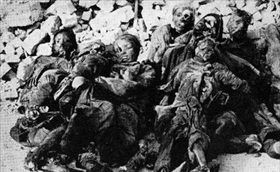GOMORRAH, “FIRE TYPHOON” PUNISH HAMBURG
Hamburg, Germany · July 24, 1943
On this date in 1943 over the North German city of Hamburg, the Royal Air Force kicked off Operation Gomorrah (July 24 to August 3, 1943). British retaliation for the Luftwaffe’s firebombing of the medieval city of Coventry in the English Midlands, where 500 tons of explosives and 56 tons of incendiaries over a 10‑hour period killed 538 Britons and destroyed the historic cathedral, had been two and a half years in the making. The Hamburg bombing tactics were nothing new: first high-explosive bombs dropped over the target to blow off roofs and open doors and windows, then incendiaries to ignite the splintered remains. The difference lay in the scale of the city-busting offensive against “the second city of the Reich.” On the night of July 24–25, 1943, 791 RAF bomber crews dropped 2,300 tons of bombs on Hamburg in little over an hour—five times more tonnage than the heaviest air raid the Luftwaffe had inflicted on the British capital, London. The fires lit by the incendiary bombs were fanned by winds, causing single blazes to merge into an inferno. The raid was repeated three days later with even more devastating effects: this time the “fire typhoon,” as contemporaries called the merged fires, caused a giant updraft that sucked in air to create a furnace that immolated 42,000 souls, set asphalt streets on fire, incinerated the city center, and destroyed 16,000 apartments; nearly one million people were left homeless. Winter coal supplies stored in cellars burned for weeks. The Britain-based U.S. Eighth Air Force joined in the destruct-a-thon, conducting 235 daylight sorties in two raids on July 25 and 26. The devastation wrought by nearly a million-and-a-half incendiaries on U‑boat pens, factories, businesses, and residences so jolted Adolf Hitler that he refused to tour the city afterwards. But Hamburg’s introduction to hell foreshadowed what Berlin would soon look like, albeit without the fiery furnace. Between the end of Gomorrah and March 1944, the RAF moved the war to Hitler’s doorstep, dispatching more than 10,000 sorties to drop over 30,000 tons of bombs on the Reich capital. It was the RAF’s supreme effort to destroy Berlin and end the war. Although aerial bombing destroyed places of production and workers’ homes, killed innocents, affected morale, and reduced the German war effort, it didn’t end the conflict. Boots on the ground did that.
[amazon_carousel widget_type=”ASINList” width=”600″ height=”200″ title=”Recommended Reading” market_place=”US” shuffle_products=”False” show_border=”False” asin=”0226595579,0802715656,0231133812,0451230086,0199668515,0743269012,0760345201,0304367249,0670025151,0306811693″ /]
Hamburg Apocalypse: Operation Gomorrah, July 24 to August 3, 1943
 |  |
Left: Burned-out multistory apartment buildings in Hamburg in 1944 or 1945. On the RAF’s second raid on Hamburg on the night of July 27–28, 1943, more than 700 aircraft of the main force dropped 2,326 tons of high explosives plus batches of four-pound incendiary sticks in a concentrated area about two miles from the city center. A German report described a “fire typhoon such as was never before witnessed, against which every human resistance was quite useless.”
![]()
Right: A Hamburg street cleared of rubble. According to an RAF assessment, at least 74 percent of Hamburg’s closely built-up residential districts were laid to waste. Luftwaffe chief Hermann Goering reported that a city with a million inhabitants “has been destroyed in a manner unparalleled in history.”
 |  |
Left: Fires smoldered, possibly in cellars storing coal, for weeks. Hamburg’s unprecedented destruction demonstrated that the Allies would win the war in Europe, and that Germany would pay dearly for every day it did not capitulate. As British Prime Minister Winston Churchill said, after the German and Italian forces began retreating from North Africa in November 1942, it was the “end of the beginning.” Hamburg in July 1943 was the beginning of the end.
![]()
Right: The destruction of 6,200 heavily urbanized acres (nearly 10 sq. miles) of Hamburg was grim. Only Berlin, with 6,427 burned-out acres, had more total area leveled, according to RAF calculations. Altogether 277,330 Hamburg apartments, 580 industrial plants, 2,632 commercial concerns, 80 Wehrmacht installations, 24 hospitals, 277 schools, and 58 churches were destroyed in Operation Gomorrah.
 |  |
Left: Hamburg’s air raid shelters and bunkers were insufficient and simply incapable of protecting its population from the effects of the Allied air campaign. All residents not engaged in the armaments industry were evacuated. Roughly 900,000 citizens left, thousands ending up in refugee settlements in Schleswig-Holstein (107,000), the Bayreuth district (58,000), Magdeburg-Anhalt (55,000), Hannover East (45,000) and Danzig, West Prussia (now Poland) (20,400).
![]()
Right: Scene confronting rescue workers entering an air raid shelter after an air raid, possibly the July 27–28 raid. Of the estimated 30,000 victims of that apocalyptic raid, most succumbed to carbon monoxide poisoning when all the air was sucked out of their shelters. By the end of November 1943, authorities had recovered 31,647 bodies, of which only 15,802 could be identified.
Silent German Film of Hamburg’s Devastation by Anglo-American Bombers During and After Operation Gomorrah, July–August 1943
![]()

 History buffs, there is good news! The Daily Chronicles of World War II is now available as an ebook for $4.99 on Amazon.com. Containing a year’s worth of dated entries from this website, the ebook brings the story of this tumultuous era to life in a compelling, authoritative, and succinct manner. Featuring inventive navigation aids, the ebook enables readers to instantly move forward or backward by month and date to different dated entries. Simple and elegant! Click
History buffs, there is good news! The Daily Chronicles of World War II is now available as an ebook for $4.99 on Amazon.com. Containing a year’s worth of dated entries from this website, the ebook brings the story of this tumultuous era to life in a compelling, authoritative, and succinct manner. Featuring inventive navigation aids, the ebook enables readers to instantly move forward or backward by month and date to different dated entries. Simple and elegant! Click 











